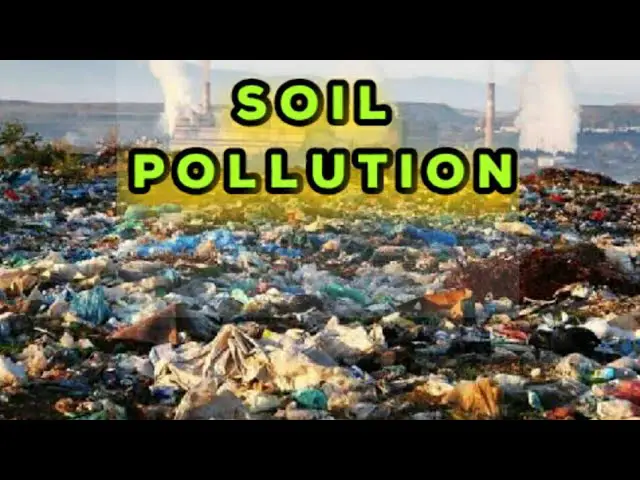The soil, the top layer of the earth’s crust, is a mixture of many solids, liquid and gaseous substances which contain both living and lifeless substances such as mineral particles, rotting organic matter, microorganisms and water present in pores and air. The construction of soil is a very slow process that starts from the weathering (foundation of the foundation stones in mineral particles) and is up to the growth of soils (minerals through mutual activity) between pedigaenesis (biological, topographical and climate factors). It may take 200 to a few thousand years to form an inch upper soil depending on the local conditions of the region. Thus the soil is an important natural resource, which has been made from centuries that supports the variety of plants and provide housing for various micro and gross life-forms, among other ecological functions.
Soil pollution: Soil pollution is so contamination with pollutants, toxic chemicals or any contamination in the soil that the soil quality decreases and it does not remain capable of organisms such as insects and other micro -organisms. Or it can also be called mixing such chemicals in the soil which are toxic to the environment and its inhabitants. This adulteration is mostly caused by irregular disposal of human activities such as mining, modern methods in agriculture, deforestation, indiscriminate dumping of waste generated by humans and untreated waste disposal of various industries.
Causes of soil pollution
1. Industrial and Mining Activities: A large number of industries are being established from the beginning of the industrial age without proper waste management systems, which are the largest contributors in soil pollution. Also, since there is an increase in the amount of mining and manufacturing and most industries are dependent on extracting minerals from the Earth. Whether it is iron ore or coal, by-products are contaminated and they are not dealt with safely. As a result, the industrial waste dumped on the surface of the soil for a long time spoils it.
2. Modern agricultural practices: Synthetic chemical pesticides and fertilizers are being used extensively over the last few decades to increase the yield from limited land area, to meet the increasing demand for food for growing population, causing extensive toxicity in the soil. They leak into the ground after being found in water and gradually reduce soil fertility. Other chemicals damage the soil structure and destroy it easily by water and air. Plants absorb many of these pesticides and when they disintegrate, they cause soil pollution because they become part of the land.
3. Lack of proper waste disposal: Modern lifestyle, both urban and rural, produce huge amounts of waste and lack of waste management processes increases the problem of soil pollution. Urban waste includes both commercial and domestic waste, including dried mud and sewage, garbage and useless ingredients such as plastic, glass, metal cans, fiber, paper, rubber, road cleaning, fuel remains, leaves, containers, left out vehicles and other manufactured products. Plastic and other non-biodegradable waste are the major causes of concern.
4. Radioactive pollutants: Atomic testing laboratories explosion, radioactive decline and nuclear dust and radioactive waste lead to radioactive substances entering the soil and accumulate by giving rise to soil pollution. For example. The waste released from nuclear reactors contains ruthenium-106, iodine-131, barium-140, Cesium-144 and Lanthanem-140 as well as primary nucleid SR-90, which is 28 years old and CS-137, which has a half-life of 30 years. Rainfall accumulates SR-90 and CS-137 on the soil, where they are firmly tied with earthen particles by electrostatic forces. All radio nucleid gamma radiation accumulated on the soil.
5. Biological factors: A large amount of human, animal and bird excreta accumulates in the soil which is a major source of land pollution by biological factors. For example, heavy use of manure and digested mud can cause severe damage to plants in a few years.
6. Contingency oil leakage: Oil leakage may occur during storage and transport of chemicals. It can be seen at most fuel stations. The chemicals present in the fuel impair soil quality and make them unsuitable for farming. These chemicals can enter ground water through soil and do not make water potable.
7. Acid rain: The acidic rainfall occurs when the pollutants present in the air fall back to the ground. Polluted water may dissolve some important nutrients found in the soil and change the structure of the soil.
Effects of soil pollution
The effects of soil pollution are not only limited to soil and its animals, but also affect every aspect of the environment and affect every living being from earthworms to humans. Some of its adverse effects are as follows:
1. Human Health: Since we are dependent on land for our food, pollution from soil reaches us in this way. There is biological accumulation of toxins in our body, causing chronic poisoning and various diseases. Reproductive health, birth and developmental defects, neurological effects, malnutrition and mutation in body cells causing cancer; All these are growing today.
2. Growth of plants: Plants will not be able to adapt to the sudden changes in the soil. The fungi and bacterial found in the soil are unable to bind the soil due to chemical changes and causes soil erosion. Large parts of the land become barren; There is no life on this. Even plants growing on these lands also absorb toxins and transfer to the food chain.
Air pollution
The poisonous dust emanating from the landfill rises with bad odor, pollutes the air and adversely affects the people living nearby.
1. Impact on human health: Given that soil is the reason that we can live our lives, its pollution has a very bad effect on our health. Crops and plants grown on polluted soil absorb a lot of pollution and then reach us. It can explain a sudden increase in minor and deadly diseases. Prolonged contact of such soil can affect the genetic structure of the body, causing congenital diseases and chronic health problems that cannot be treated easily. In fact, it can cause livestock to a large extent and lead to prolonged food poisoning. If the plants are unable to grow in it, soil pollution may also cause widespread famine.
2. Effect on growth of plants: The ecological balance of any system is affected due to widespread pollution of soil. When soil chemistry changes so fast in a short time, most plants are unable to adapt. The fungi and bacteria found in the soil that tie it together, start decreasing, causing additional problems of soil erosion. Fertility gradually decreases, which makes the land inappropriate to survive agriculture and any local vegetation. Large parts of the land become dangerous for health due to soil pollution. Unlike deserts, which are suitable for its original flora, such land cannot support most types of life.
3. Reduction in soil fertility: The toxic chemicals present in the soil can reduce soil fertility and hence can reduce soil yield. Contaminated soil is then used for the production of fruits and vegetables, which lack quality nutrients and may contain some toxic substances that can cause serious health problems in people eating them.
4. Effect on landscape and smell pollution: Piles of garbage and garbage thrown in an area spoil the peace of landscape. Poisonous and dirty gases emanating from landfill pollute the environment and have a serious effect on some people’s health. Unpleasant smell causes discomfort to other people.
5. Changes in soil structure: The death of many soil organisms (such as earthworms, insects and micro organisms) in the soil can change the structure of the soil. In addition, it can force their predators to go to other places in search of food.
6. Effect on ecosystem and biodiversity: Soil pollution can lead to lack of biodiversity in the ecosystem. The life of birds, insects, mammals and reptiles living in soil can be affected by pollution. The soil is an important housing.
7. Pollution of water sources: When it rains, the water flowing from the surface takes the contaminated soil to the water sources, causing water pollution. Pollutants can also enter down to contaminate groundwater. Thus contaminated water is unsuitable for consumption of both animals and humans. It will also affect aquatic life because the organisms living in these water bodies will not find them living in their houses.
Control measures for soil erosion
A. Prevention of soil erosion:
1. Conservation plowing or unnecessary farming: traditionally, the land is plowed to create a planting surface. It bothers the soil and makes it susceptible to erosion. The unnecessary cultivation method causes the least damage to the upper soil by piercing the uncovered soil. Seeds, fertilizers and water are added to these holes.
2. contour cultivation: In this method, crops are gradually planted in rows along the contour of sloping land. Each row acts as a small dam to catch the soil, which slows down the flow of water.
3. Stayed Cultivation: In this method, steep slopes are converted into a range of wide roofs moving across the contour. It maintains water for crops and reduces soil erosion by controlling runoff.
4. Street crop or agricultural forestry: This method involves planting crops in straps or streets between rows of trees or shrubs that provide fruit and fuel wood. Therefore, when the crop is harvested, there will be no erosion of soil because trees and shrubs hold soil particles and stay on the ground. 5. Wind barrier or shelter belt: In this technique, trees are planted in long rows with the range of cultivated land that prevent air and reduce soil erosion. Pawan blocks help maintain soil moisture, supply wood for fuel and provide housing for birds.
B. Ways to reduce the process of soil acidication:
- Use of less acidic farming methods: maintaining crop residues, no nitrate residue, less plowing etc.
- Use of agriculture lime: The soil mixture increases the pH of some prescribed value (pH 6.0 to 7.0).
C. Measures to cure salt affected soil
1. Deep plowing: Deep plowing can improve drainage for high salt level soils. This method works by breaking the layers of hard soil or rock -like soil which prevents the flow under water. But it is usually temporary, as some parts of the soil can be tightened and seal again.
2. Flushing of soil and preventing evaporation: Flushing of soil is the process of irrigating the area with low salt water and washing salt under the root area; Provided that the drainage in the soil is good. When the water evaporates on the surface of the dry soil, it leaves the salt behind. Mulching can help maintain soil moisture.
3. Chemical remedies: Modifying salfers, lime or calcium with salty soil can help in removing or replacing sodium in the soil. But before applying chemical treatment, many factors such as groundwater, soil conditions, geological factors etc. of the area should be considered.
4. Combination of methods: A joint approach can be more effective. Start with the correct modification and work using deep plowing. Then wash the soil with water to remove the salt from the surface. If necessary, repeat this process.
5. Land improvement: Land improvement includes activities concentrated towards restoration of previous organic matter and important soils of soil. This may include activities such as adding plant residues in poor soil and improving range management. Salin soil can be restored by salt level improvement improvement projects and salinity control. Maharashtra is a project funded by the World Bank to recover the land in Maharashtra, affecting 1,000 villages in the state. A significant percentage of land is in the suicide-prone Vidarbha region of farmers.
D. Durable practices:
Many sustainable practices can be applied to prevent desertization from spreading. Such as the following:
- Stopping excessive grazing- Plants will grow again due to having less animals in the same area.
- Keep integrated cultivation- keep animals and grow crops. Where crops grow, use fertilizer obtained from animals to replace soil nutrients. From time to time change the place where crops grow and animals graze.
- Plant more trees- These will protect the soil surface from the effects of rain and wind. The roots will tie the soil together and trap the water.
- Create earthen dams- These are small dams that follow the soil outline. When it rains, the water does not flow from the surface, but gets trapped and penetrates into the soil.
E. Production and use of natural fertilizers: To prevent harmful effects of chemical fertilizers, biological methods of soil fertility are being adopted. Organic farming should be practiced.
F. Education: Education is an important tool that should be used to help people understand the best use of land. By educating them about sustainable practices, more land will be saved from being polluted.
Read Also:
- Water Pollution: Reasons, Negative Effects And Prevention Methods
- Effects Of Environmental Pollution
- Causes Of Environmental Pollution
- Major Types Of Pollution
- Environmental Pollution
- Effects Of Pollution On Aquatic Biota
- A Review On The Effects Of Water Pollution On Freshwater Fish Species
- Water Pollution: Causes, Negative Effects And Prevention Methods
- Prevention Of Water Pollution
- Effects And Control Ways of Water Pollution
- Causes Of Water Pollution
- Introduction To Water Pollution
- Introduction To Air Quality And Pollution Control
- Introduction And History Of Anthropogenic Pollution






